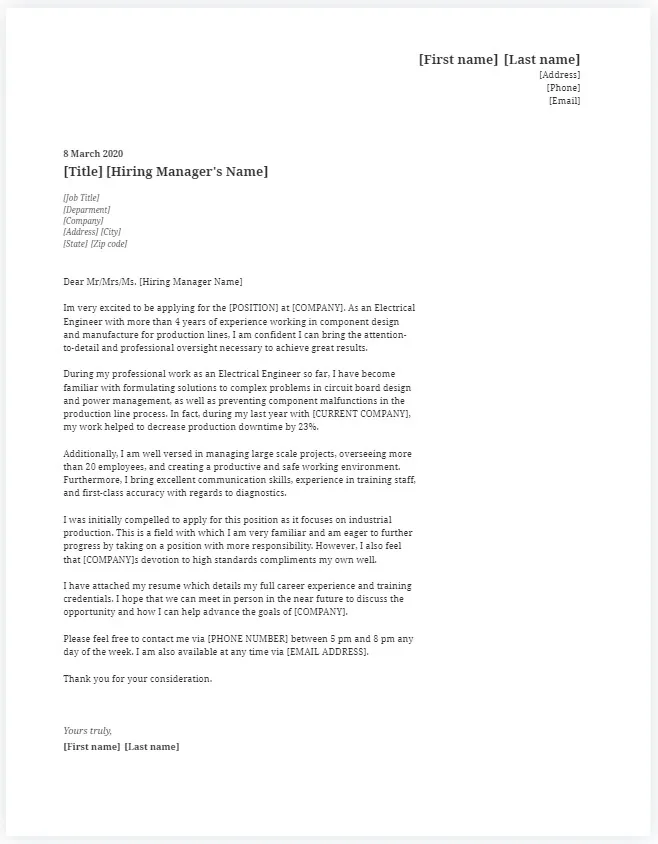The Power of a Perfect Engineering Cover Letter
In the competitive landscape of engineering, a well-crafted cover letter is your primary opportunity to make a compelling first impression. It’s not merely a formality; it’s your chance to showcase your technical acumen, communication skills, and genuine enthusiasm for a specific role. While your resume presents the facts, the cover letter weaves a narrative, connecting your skills and experiences to the employer’s needs. A strong cover letter demonstrates your understanding of the job requirements, your familiarity with the company, and your motivation to contribute to their success. Mastering the art of cover letter writing is, therefore, a critical skill for any engineer seeking career advancement. This document allows you to go beyond the basic information and highlight what makes you the ideal candidate.
Understanding the Role of a Cover Letter
Why a Cover Letter Matters

The primary role of a cover letter is to introduce you to a potential employer, providing context and personality to your resume. In the precise and detail-oriented field of engineering, a well-written cover letter showcases your ability to communicate complex ideas clearly and concisely, an essential skill for any engineer. It allows you to elaborate on specific projects, experiences, and skills that directly align with the job description, demonstrating a genuine interest in the position and the company. A compelling cover letter significantly increases your chances of being noticed by the hiring manager, leading to an interview and, ultimately, a job offer. Neglecting this critical step in the application process leaves you at a disadvantage compared to candidates who leverage this powerful tool. Think of it as your personal sales pitch, selling your skills and experiences to the company.
Key Components of an Effective Cover Letter
Header and Contact Information
Start with a professional header that includes your full name, contact information (phone number, email address, and LinkedIn profile URL, if applicable), and the date. Ensure your contact information is up-to-date and easily accessible. Also, include the recipient’s information, such as the hiring manager’s name and the company’s address. A properly formatted header immediately conveys professionalism and attention to detail, signaling to the employer that you are serious about the application process. This is the first impression; it sets the tone for the rest of your application. Accuracy and professional presentation at this stage are crucial, showing you understand the standards expected in the engineering field. Include your professional email address and, if you have one, your portfolio link.
Professional Greeting
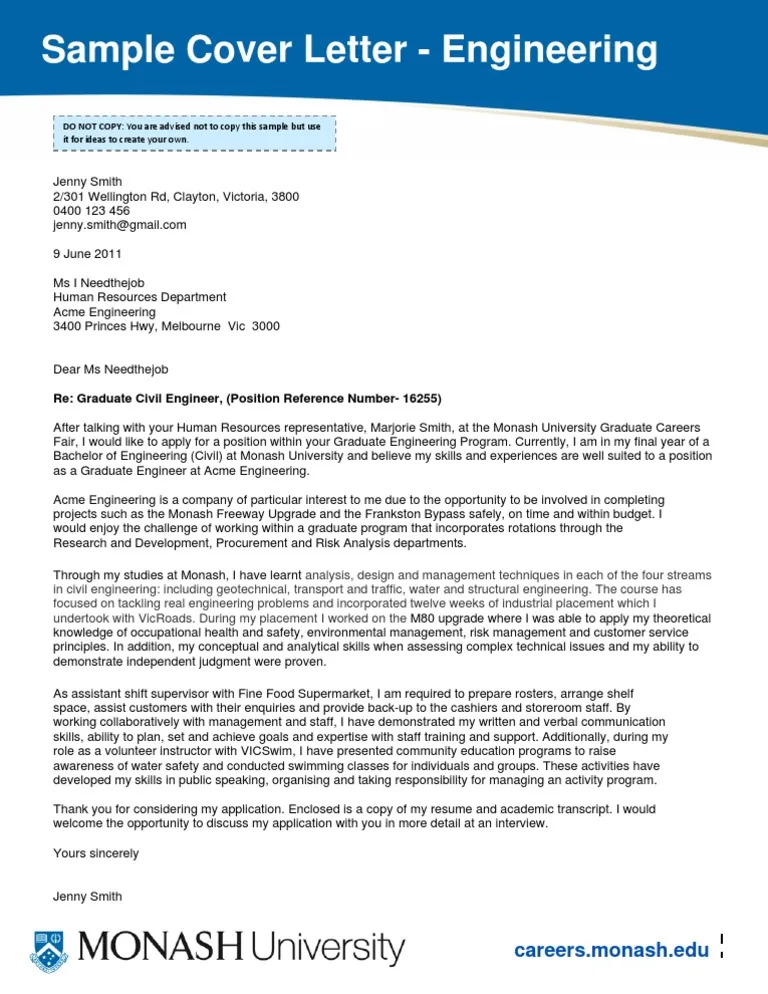
Addressing the hiring manager by name is always preferable. Research the company to find out who the hiring manager is for the specific position. A personalized greeting like “Dear Mr./Ms. [Last Name]” shows that you’ve taken the initiative to learn about the company and the role. Avoid generic greetings such as “To Whom It May Concern” or “Dear Sir/Madam,” as they can make your cover letter feel impersonal. If you cannot find a specific name, use a more general, yet still professional greeting such as “Dear Hiring Manager.” This small step of personalizing the greeting will make your letter stand out and convey respect and consideration for the hiring manager’s time. It indicates that you are genuinely interested in the position and the company.
Introduction and Hook
Your introduction is your chance to capture the reader’s attention. Start with a strong statement that immediately conveys your interest in the position and the company. Mention where you saw the job posting and briefly state why you are a great fit for the role. You can also include a brief overview of your most relevant skills and experience. Avoid generic introductions that lack impact. Instead, aim to create a compelling opening that makes the hiring manager eager to read the rest of your letter. The introduction should clearly state your understanding of the job requirements and your ability to fulfill them. Your hook could be a short, impactful statement that highlights your passion for engineering or a key achievement that directly relates to the job.
Showcasing Your Skills and Experience
Highlighting Relevant Skills
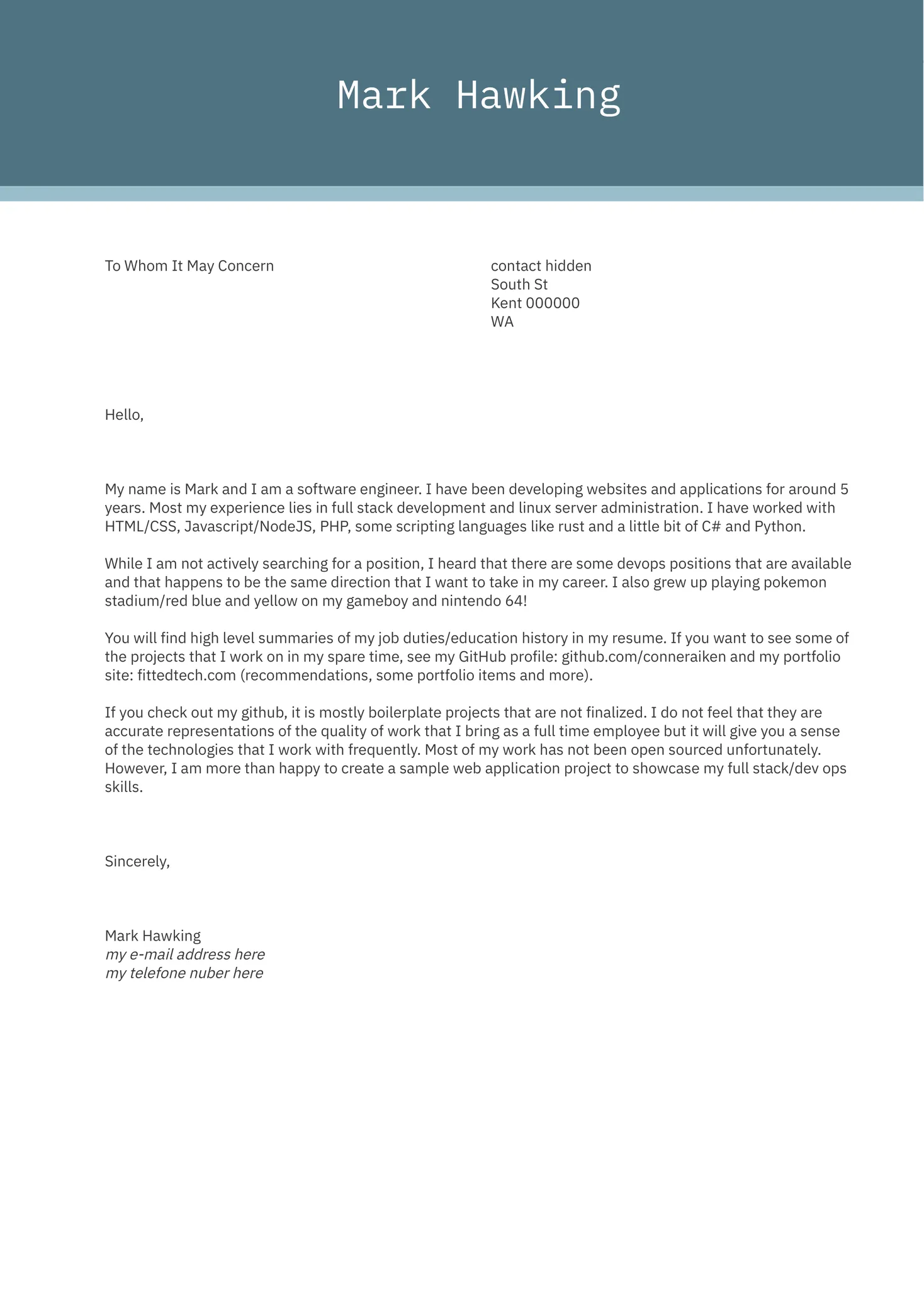
Carefully review the job description and identify the key skills and qualifications the employer is seeking. Tailor your cover letter to highlight these skills, providing specific examples of how you’ve used them in previous roles or projects. Use action verbs to describe your accomplishments, such as “designed,” “developed,” “managed,” or “analyzed.” Quantify your achievements whenever possible to demonstrate the impact of your work. For example, instead of saying “Improved efficiency,” say “Improved efficiency by 15% through the implementation of a new process.” This specific approach brings your skills to life and gives the hiring manager concrete evidence of your capabilities. Be specific and provide concrete examples of your skills in action, using data whenever possible.
Quantifying Achievements
Provide quantifiable results to demonstrate your impact in previous roles. Use numbers, percentages, and specific data to showcase your achievements. Instead of stating “Managed projects successfully,” specify “Managed projects with budgets up to $1 million, delivering them on time and under budget 90% of the time.” This data provides concrete evidence of your ability and the value you bring to the table. Use metrics such as cost savings, project completion rates, efficiency improvements, or revenue generated. Quantifying your accomplishments makes your cover letter more compelling and gives the hiring manager a clear understanding of your ability to deliver results. Quantifiable results provide objective evidence of your capabilities and impact. Whenever possible, back up your claims with hard data.
Tailoring Your Cover Letter to the Job
Researching the Company

Before writing your cover letter, thoroughly research the company and the specific job requirements. Understand their mission, values, and recent projects. This research will help you tailor your letter to demonstrate your understanding of the company’s needs and how your skills align with their goals. Visit the company’s website, read news articles, and check their social media profiles to gain insights into their culture and projects. Mention specific projects or aspects of the company that resonate with you, showing your genuine interest and enthusiasm. Tailoring your cover letter demonstrates your dedication and ensures that it’s relevant to the company’s specific needs. Show the company you have a genuine interest in their work.
Matching Skills to Job Requirements
Carefully analyze the job description and identify the essential skills and qualifications. Then, align your skills and experience with these requirements. Provide specific examples of how you have used these skills in past roles, projects, or academic experiences. Use the same keywords and phrases from the job description to show that you understand the requirements. This approach makes it easy for the hiring manager to see how your qualifications match their needs. The best cover letters act as a roadmap, directing the hiring manager directly to the key aspects of your experience that align with what they seek. Make the match clear; the hiring manager should be able to see how your skills align with their needs quickly and easily.
Addressing the Hiring Manager
Addressing the hiring manager by name is important. If possible, research the hiring manager’s name and title. A personalized cover letter immediately captures the reader’s attention. If you cannot find the name of the hiring manager, use a more general, yet still professional greeting such as, “Dear Hiring Manager.” Avoid generic greetings like “To Whom It May Concern,” which indicate a lack of effort and interest. Personalization can demonstrate that you value the time of the person reading your cover letter. Take the extra step to find out who the hiring manager is; this shows initiative and attention to detail. Be sure to check the spelling.
Writing a Strong Closing
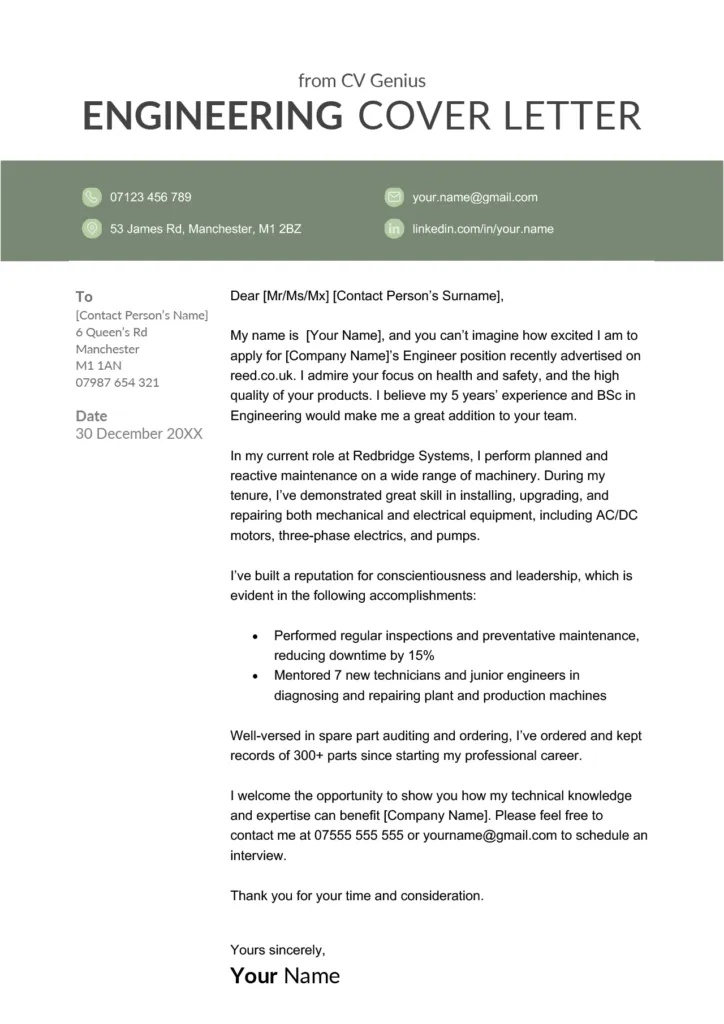
Expressing Enthusiasm and Call to Action
In your closing paragraph, reiterate your interest in the position and the company. Express your enthusiasm for the opportunity to contribute to the team and mention your eagerness to discuss your qualifications further. Include a clear call to action, such as inviting the hiring manager to contact you for an interview. State your availability for an interview and thank them for their time and consideration. A strong closing leaves a lasting positive impression and encourages the hiring manager to take the next step in the hiring process. Close with a professional closing, such as “Sincerely” or “Best regards,” followed by your full name. Make it easy for the hiring manager to contact you: Provide your phone number and email address once more, ensuring all contact information is correct. This reinforces your interest and makes it simple for the recruiter to take the next step in the hiring process.
Formatting and Proofreading
Formatting Tips
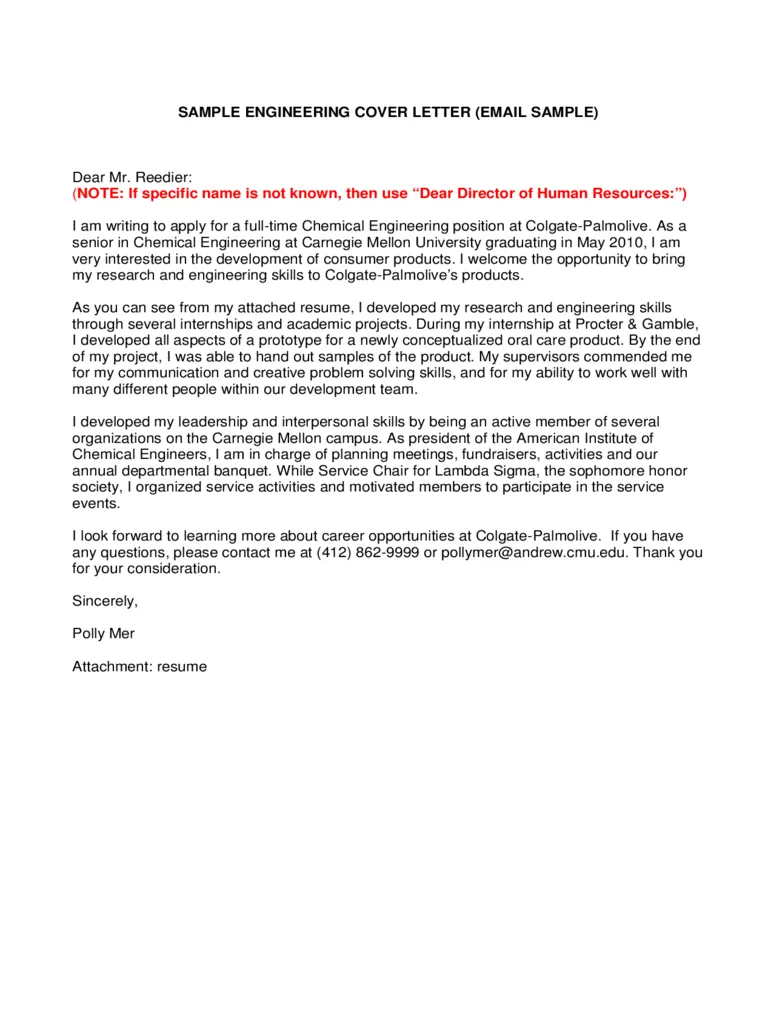
Use a professional and easy-to-read font, such as Times New Roman, Arial, or Calibri, with a font size between 10 and 12 points. Ensure your cover letter is well-organized with clear headings, subheadings, and bullet points to make it easy to read. Use single-spaced lines with a space between paragraphs. Keep the letter concise, ideally within one page. Make sure the format is consistent throughout the entire document. Clean formatting makes your cover letter appealing to the eye and allows the reader to quickly grasp key information. A well-formatted cover letter shows attention to detail, reflecting positively on your professionalism. Proper formatting is important to create a professional and readable document. Avoid excessive colors or unusual fonts.
Proofreading for Errors
Proofread your cover letter meticulously for any errors in grammar, spelling, punctuation, and formatting. Errors can undermine your credibility and create a negative impression. Use a spell checker and grammar checker, but don’t rely on them entirely. Read your letter aloud to catch any awkward phrasing or typos. Ask a friend, family member, or career advisor to proofread it as well. Taking the time to thoroughly proofread is an essential step that will ensure your cover letter presents you in the best possible light, showcasing your attention to detail. Ensure there are no typos and the grammar is perfect. Proofreading is crucial; make sure a second person checks your cover letter.
Cover Letter Examples to Learn From
Engineering Cover Letter Sample 1
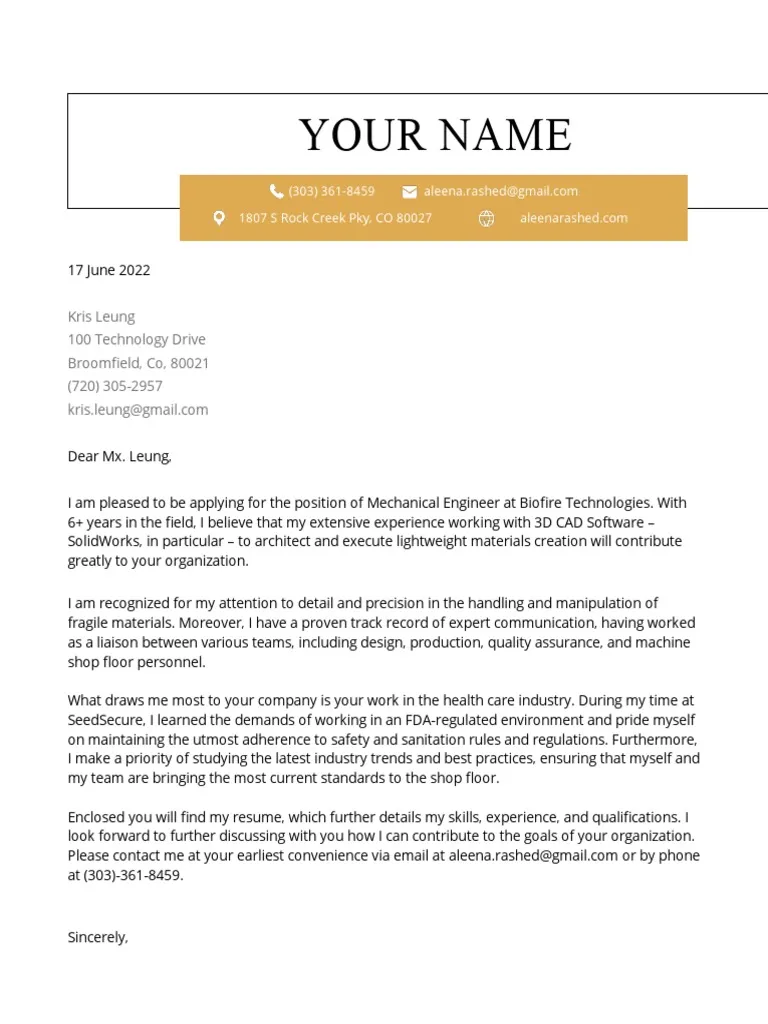
[Insert Sample Cover Letter 1 Here: Include a sample cover letter for an engineering position, highlighting relevant skills, achievements, and tailored to the specific job description. The sample should include a professional header, a personalized greeting, an engaging introduction, and a strong closing with a call to action. Ensure it demonstrates the candidate’s passion for engineering, their ability to solve problems, and their enthusiasm for the specific role. The content of the cover letter should align with the previous sections, exemplifying the guidelines mentioned. This provides a practical example of an effective cover letter.]
Engineering Cover Letter Sample 2
[Insert Sample Cover Letter 2 Here: Include a second sample cover letter for an engineering position, showing different approaches to addressing the requirements and showcasing the candidate’s unique qualifications. The second sample should also have a professional header, a personalized greeting, an engaging introduction, and a strong closing with a call to action. It should demonstrate a different set of skills or experiences, as well as an understanding of another type of engineering role. The second sample should provide another example, offering diversity in styles.]
Common Mistakes to Avoid
Generic Cover Letters
One of the most significant mistakes is sending out generic cover letters that are not tailored to the specific job or company. Generic cover letters fail to demonstrate to the hiring manager that you’ve taken the time to understand their needs and that you are genuinely interested in the position. This can make your application easily overlooked. Ensure you customize each cover letter to reflect the specific requirements of the job and highlight the skills and experiences that are most relevant. Your application can show the value you can offer, and how you can align with the company and the role. Tailor the cover letter to the specific company and position; this shows you are interested in this opportunity.
Typos and Grammatical Errors
Typos and grammatical errors can damage your credibility and demonstrate a lack of attention to detail. Always proofread your cover letter meticulously, using spell-check and grammar-check tools, but don’t rely on them solely. Read your letter aloud to catch any awkward phrasing or mistakes that might be missed during a quick scan. Ask someone else to review your cover letter for additional feedback. Ensuring your letter is free of errors communicates professionalism and the capability to convey clear information. Typos and grammatical errors can make a negative impression, highlighting a lack of attention to detail, which is especially detrimental in engineering.
Ignoring the Job Description
Failing to address the requirements of the job description is a critical mistake. Carefully review the job description and highlight the skills and experiences that align with those requirements. Your cover letter should act as a roadmap, guiding the hiring manager directly to the key aspects of your experience that they are looking for. Ignoring the job description can result in your application being discarded, as it indicates a lack of interest in the role or an inability to meet its specific demands. Tailor your cover letter to demonstrate how your qualifications match the requirements and what value you bring to the company. Align your cover letter directly with the job description, using keywords to demonstrate you meet the criteria.
Conclusion
Writing an effective cover letter for engineering jobs is essential for making a strong impression and increasing your chances of getting hired. By following the guidelines and tips discussed in this article, you can create a cover letter that highlights your skills, experience, and passion for engineering. Tailor your cover letter to the specific job requirements, showcase your accomplishments with quantifiable results, and demonstrate your understanding of the company’s needs. Remember to proofread carefully and avoid common mistakes, such as generic cover letters and grammatical errors. A well-crafted cover letter can be your key to success in landing your dream engineering job. Implement these strategies to help you stand out from the competition and make a lasting impact on potential employers, paving the way for a successful career in engineering. Your cover letter is your chance to shine, so make sure it reflects your best self and showcases your potential.
